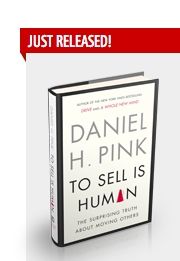 Selling in all its dimensions has changed more in the last ten years that it did over the previous hundred. Most of what we think we understand about selling is constructed atop a foundation of assumptions that has crumbled. Daniel H. Pink.
Selling in all its dimensions has changed more in the last ten years that it did over the previous hundred. Most of what we think we understand about selling is constructed atop a foundation of assumptions that has crumbled. Daniel H. Pink.
Oh so true. I’d like to take you through the essential thesis of the book with comments on how I’ve had success with these principles over the last 5 to 10 years. The stand out element of Daniel’s books is that they’re based on the latest research the book breaks down into 2 essential parts – How To Be and What To Do. The How To Be redefines the ABC of selling.
ABC
At one time it stood for “Always Be Closing” now it should stand for Attunement, Buoyancy and Clarity.
ATTUNEMENT
Attunement is more than just empathy. It’s a mixture of approaches, perspective thinking, mimicking strategically, and understanding the Ambivert personality.
Perspective thinking – is not just about understanding the cast of characters in your prospects business but also their relationships and connections to others. Not just who reports to whom but their biases. How they see the world.
My take: This is key to selling today. It’s not good enough to identify your sponsor who you are trying to help. You need to identify the drivers and biases around your sponsor, their bosses, their influential colleagues and associates.
Mimicking Strategically – Being a chameleon is a valuable skill. Carefully following the tone of someone on the phone or following the body language can be helpful as the research makes clear. But the key is not to get noticed or it can backfire!
My Take: All selling is basically a negotiation. And bending one’s style to each situation is clear. Negotiation like selling isn’t a one fit all solution. Each case needs careful assessment to decide the best tactics to deploy. Mimicking is a practiced art and it takes quite a while before amateurs can become professional.
Ambivert – Research shows that the maximum revenue generated by sales professionals are those with Ambivert personalities. Ambiverts are people who are neither overly extraverted nor wildly introverted. So be aware of where you are on the introvert to extravert scale and compensate. Test yourself here .
My Take: Be careful to be yourself. Don’t overcompensate to be someone you are not. Perhaps just tone down those extravert moves a shade. Or if you are mainly introverted in your approach look for key moves that bring more confidence into your dialogue.
BUOYANCY
Buoyancy is about combining grittiness of spirit and sunniness of outlook. Daniel explains buoyancy using three themes: What you tell yourself before a sales conversation, how your positivity ratio during a conversation matters, and finally how you explain to yourself what happened after the sales conversation are key.
My Take: The key for me is your personal mindset. Getting yourself focused for a great sales day is key. Exceptional preparation materially improves your odds. Belief in what you’re selling drives you into a positive frame of mind.
CLARITY
Daniel defines this as the capacity to help others see their situations in fresh and more revealing ways and to identify problems they didn’t realize they had. Problem finders is the key evolving from the old problem solver. He encourages sales professionals to find the right questions. Secondly he explains the importance of framing eg the experience frame is about how people will use your product.
My Take: Anyone reading this blog for the last year knows my passion for questions. You are defined by the questions you ask. Diagnostic questions bring out the real story of the prospect. This is so often different from their belief before you engaged them in a conversation. A sales process that fails to diagnose what is really happening on the ground, inside the prospects world has no chance of designing a solution that will improve the prospects world.
In a later blog post I will take a look at the second part of the book on actions you should take based on this approach. The principles of Pitching, Improvising and Serving.
The book link is here.








Fabulous post Ian. I took the test – I am an Ambivert – I’ve been called worse…
Best, Paul
A lot worse and that’s just your friends talking!
Ian: I like your advice to be true to yourself. I did Pink’s test and I am an ambivert. Could it be the case that I have a background as a purchaser and that I have a keen interest in business philosophy? 😉
Martin please join the conversation anytime. Hope you enjoy the book.